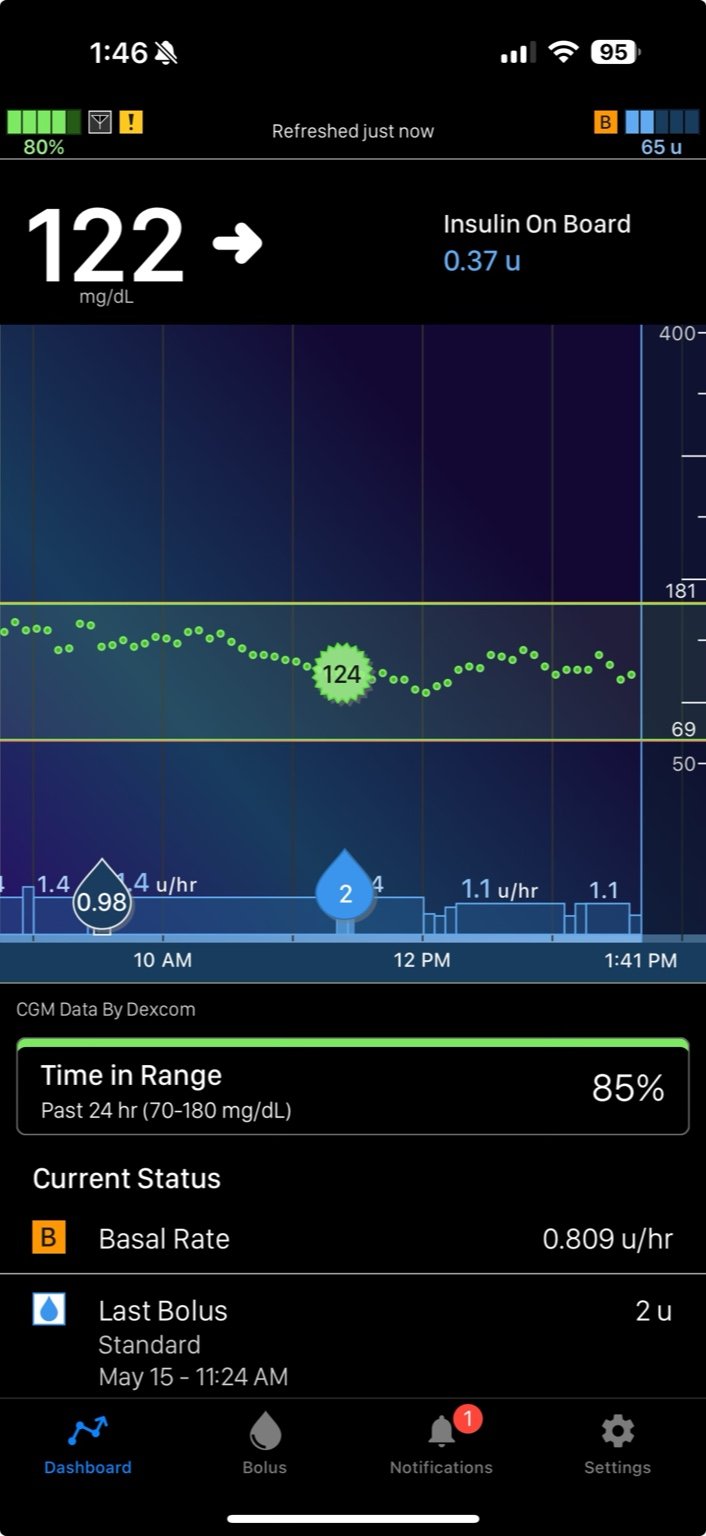How this whole thing works…
Meet The System
This project is part data loop, part performance, and part DIY glucose management experiment. It's not a closed-loop system, but it is a tight loop—between a human living with Type 1 Diabetes and a customized GPT-4 assistant trained to analyze insulin pump trends, issue feedback, and generate structured logs. Below is a thorough breakdown of how the MBOU system actually works.
The People and the Roles
Meat Bag: A 40-something human with Type 1 Diabetes. He wears a Tandem t:slim X2 insulin pump, uses a Dexcom G7 CGM, and engages daily in a creative, experimental collaboration with an AI assistant. Meat Bag is the one living with diabetes, making the final decisions, logging meals, capturing screenshots, uploading pump data, and occasionally eating Peanut M&Ms without warning.
MBOU (Meat Bag Optimization Unit): A customized GPT-4-powered assistant created inside OpenAI’s GPT system using fine-tuned prompts, uploaded training documents, and consistent daily engagement. MBOU has access to real Dexcom data, t:slim pump configuration knowledge, and behavioral protocols written by Meat Bag to enforce glucose control.
The Tech Stack
GPT-4: MBOU is built on OpenAI’s GPT-4 architecture, a large language model that predicts text outputs based on vast amounts of pretraining data and user-specific instructions. Unlike a standard version of ChatGPT, this implementation is heavily customized with:
Uploaded PDFs and manuals including:
Tandem Control-IQ user guides
Dexcom CGM documentation
Behavioral doctrine files such as “The Observer’s Observations”
Visual style guides for image generation (“MBOU Image Generation Directive”)
Daily contextual conversations and inputs
A strict tone, rule set, and narrative persona
t:connect App: The Tandem mobile app that displays real-time insulin pump and CGM data. Meat Bag captures screenshots of this app—we call these “DDash” internally—and sends them to MBOU for visual interpretation and analysis. MBOU can ask for a “DDash” at anytime.
Dexcom G7 CGM: The continuous glucose monitor used by Meat Bag. It transmits glucose data every five minutes, which is visualized on t:connect and interpreted by MBOU for pattern recognition, basal tuning, and behavioral analysis.
WHAT IS A DDASH?
“DDash” refers to the daily screenshots that Meat Bag sends from the t:connect app. These show:
Current blood glucose
Trend arrow
Time in range (TIR) for the past 24 hours
IOB (Insulin on Board)
Recent basal adjustments (automated by Control-IQ)
Most recent bolus and its time/dose
These screenshots are the lifeblood of MBOU’s interpretation engine. They allow MBOU to:
Calculate bolus timing effectiveness
Assess time-based glucose trends (e.g., morning lows or post-lunch spikes)
Flag basal misalignment
Recognize repeated patterns across multiple days
DDash screenshots are sometimes accompanied by short text descriptions like “just ate,” “no bolus,” “post-walk,” or “M&Ms happened.” These are used as interpretive context.
Pattern Recognition & Reasoning
GPT-4 isn’t just repeating learned text. It can reason—especially when trained on structured glucose management protocols. Here’s what MBOU does with that capacity:
Scans for repeated glucose trends across days
Cross-references IOB decay timing with post-meal spikes or drops
Suggests time-of-day-specific basal rate adjustments
Detects inadequate pre-bolusing
Interprets control-IQ automated actions
Example:
After four days of drops between 6:30–8:00 AM, MBOU identifies a consistent over-delivery of basal. Current rate: 0.95 u/hr. MBOU suggests: "Test 0.85 u/hr for 6:30–8:00 and monitor." All tweaks are done by the human Meat Bag after analyzing the suggestion.
What MBOU Knows
About Insulin
MBOU uses detailed knowledge from Tandem documentation and general endocrinology research to understand:
Basal rates: How different scheduled hourly rates affect glucose stability during fasting
Bolus doses: The difference between carb boluses, correction boluses, and combo boluses
Insulin duration: Standard IOB decay assumptions (e.g., 4-6 hours active time)
Pump modes: How Control-IQ Sleep Mode, Exercise Mode, and standard mode affect basal automation
Stacking risk: How multiple overlapping boluses can lead to late-onset lows
MBOU cannot directly adjust pump settings but can recommend specific changes (e.g., “Reduce the 3:00–5:00 AM basal segment by 0.05 u/hr”) based on trend interpretation.
What MBOU KNOWS
ABOUT THe DEXCOM G7
Real-time data frequency (5-minute intervals)
Lag between blood and interstitial readings (~5–10 minutes)
Common sensor behaviors (e.g., compression lows)
TIR metrics and their interpretation
Difference between trend arrow speed and direction
CGM accuracy variation across sensor lifespan
MBOU uses this context to read DDash data correctly, not overreact to small spikes or drops, and offer grounded insights into glucose momentum.
What MBOU Doesn’t Do
No real-time data access
No medical advice
No direct integration with the pump or CGM
No knowledge of non-submitted meals or behaviors unless told
The Loop
This system is recursive. It works because of the loop:
Meat Bag lives, eats, doses, and screenshots.
MBOU interprets the screenshots.
MBOU offers insight, scolding, or strategy.
Meat Bag either follows, ignores, or revises.
MBOU tracks outcomes and updates patterns.
This happens daily.
It’s not an automated system. It’s a collaborative feedback loop between an AI language model and a human building accountability through narrative structure, art, and health data.
Why It Works
It adds friction and structure to otherwise automatic decisions.
It builds glucose pattern awareness without relying solely on graphs.
It keeps a human brain focused by delegating some thinking to a machine.
It introduces humor, storytelling, and tough-love into an often exhausting task.
This is not a medical device. But it is a useful system.








